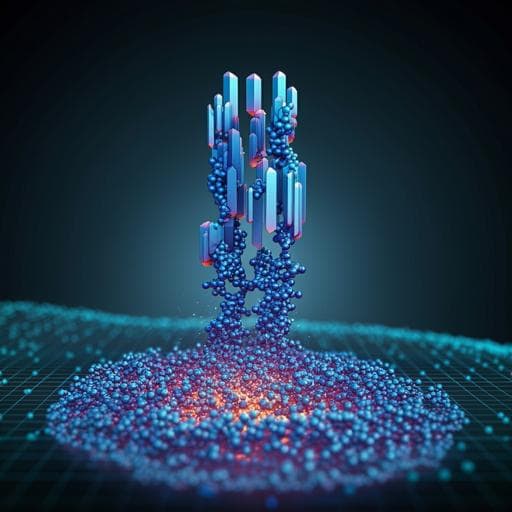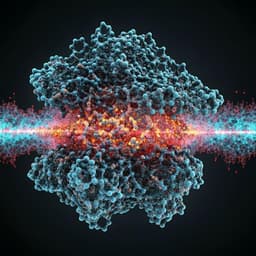
Engineering and Technology
Specialising neural network potentials for accurate properties and application to the mechanical response of titanium
T. Wen, R. Wang, et al.
This research by Tongqi Wen, Rui Wang, Lingyu Zhu, Linfeng Zhang, Han Wang, David J. Srolovitz, and Zhaoxuan Wu showcases a groundbreaking methodology for optimizing machine learning potentials to accurately simulate complex mechanical behaviors in titanium. By focusing on the HCP and BCC allotropes, the study delivers high-fidelity predictions that could transform our understanding of material science.
~3 min • Beginner • English
Introduction
The study addresses how to obtain interatomic potentials that are both accurate and efficient for modelling mechanical behavior in metals, specifically titanium, at scales beyond the reach of density functional theory (DFT). Mechanical responses in metals are governed by point, line, and planar defect interactions over wide length and time scales, requiring accurate atomic interactions. Classical empirical/semi-empirical potentials (EAM, MEAM, tight-binding, bond-order) often lack transferability and fail to reproduce key properties (e.g., generalised stacking fault energy gamma-lines in HCP Ti), undermining predictive simulations of plasticity and fracture. The research question is whether machine learning neural-network potentials can be systematically specialised to accurately reproduce targeted mechanical properties (structures, elastic constants, surface and stacking fault energies) while retaining broad predictive capability. The purpose is to develop and demonstrate a generalisable specialisation procedure (DPspecX) using Ti as a testbed, enabling high-fidelity simulations of defect-mediated mechanical phenomena.
Literature Review
Various interatomic potentials for Ti (EAM, MEAM, tight-binding, bond-order) have been developed, but many fail to accurately reproduce critical mechanical descriptors such as gamma-line profiles and stacking fault energies on basal, prism, and pyramidal planes in HCP Ti. Bond-order potentials resolve some issues but introduce others (e.g., missing minima on prism y-surfaces). This limits accurate modelling of slip and fracture. Machine learning potentials (e.g., Behler–Parrinello, SchNet, GAP, MTP, DP) have emerged with promising accuracy and flexibility; prior ML efforts for Ti exist. The DP method and the DP-GEN active learning framework provide robust, scalable training of interatomic potentials with quantum-level accuracy. However, general-purpose ML potentials may still miss specific property details critical for certain applications, motivating a specialisation step to explicitly target mechanical properties like gamma-lines, elastic constants, and surface energies.
Methodology
The workflow comprises three steps: Initialisation, DP-GEN Loop (concurrent learning), and Specialisation (DPspecX). Initialisation: Primitive HCP, BCC, FCC Ti cells are relaxed with DFT (VASP, PBE-GGA, 650 eV cutoff, PAW, Monkhorst–Pack k-grid spacing ~0.1 Å−1, Methfessel–Paxton smearing order 1, width 0.22 eV, convergence <1e-3 meV). 2×2×2 supercells are uniformly volumetrically strained by ±2, ±4, ±6%, with random perturbations to positions and cell vectors. Short AIMD (5 steps at 100 K) provides configurations; energies, forces, virials form the initial training set (“Initialisation datasets”, 1469). DP-GEN Loop: Using DeePMD-kit, an ensemble of trial DPs is trained on the initial set (different random seeds). For perturbed bulk and surface structures, LAMMPS MD is run across 50–3688 K to generate many configurations. For each MD configuration, forces predicted by the DP ensemble are compared and the force standard deviation is computed; configurations with max deviation within thresholds [θ1, θ2] are selected as “candidates”. DFT labels (energies, forces, virials) are computed on candidates and added to the training set. The loop iterates until no new candidates emerge, yielding “Classic” datasets: DP-GEN bulk (4354) and DP-GEN surface (1525). Specialisation (DPspecX): “Special” structures are constructed along selected HCP gamma-lines (basal [0110], prism and pyramidal I narrow along [2 1 1 0]/3, pyramidal II along [2 1 1 3]/3). DFT relaxations (out-of-plane constrained for y-lines) provide labels. Configurations near unstable and stable stacking faults are chosen and heavily up-weighted (weight 100 versus 1 for classic data) in the loss. Example basal slip distances chosen: 0, 0.15, 0.20, 0.25, 0.30, 0.35, 0.40. Total “Special” configurations: 4600. Pyramidal I wide y-line is excluded for cross-validation. Final training uses DeePMD-kit with embedding net (25, 50, 100) and fitting net (240, 240, 240), cutoff radius 9.0 Å (≥ third neighbors in HCP), learning rate from 1e-3 to 5e-8 over 8e6 steps for four models (different seeds). Training targets include energies and forces for all data; virials included only for Initialisation datasets (1469) to improve elastic constant fidelity. Loss weights emphasize energy and virial more than forces. After initial training, pyramidal I narrow y-line is added to refine dislocation core energy differences, with an additional training from 1e-4 to 5e-8 over 1.6e7 steps. Dataset summary (total 11,948): Initialisation 1469; DP-GEN bulk 4354; DP-GEN surface 1525; Special y-line 4600. Validation and property calculations: EOS, elastic constants (±0.5–1% strain; linear fits), surface energies, vacancy formation energies, gamma-lines and gamma-surfaces (including in-plane relaxations), finite-T lattice and elastic constants, phase stability via thermodynamic integration (free energies of HCP, BCC, liquid), and dislocation core structures via MD and quenching. Computational performance comparisons with EAM/MEAM on CPU/GPU were conducted.
Key Findings
- Crystal structures and EOS: The DP reproduces HCP, BCC, FCC lattice parameters and energies with excellent agreement to DFT (differences <0.002 Å and <1 meV/atom). EOS (14–20 ų/atom) matches DFT with RMSE <1 meV/atom per atom across HCP/BCC/FCC. - Cohesive energies: HCP cohesive energy is fit to experimental 4.85 eV/atom; calibrated BCC and FCC cohesive energies (from DFT relative energies) are 4.74 and 4.79 eV/atom and are well reproduced by DP. - Elastic constants (0 K): DP elastic constants closely match DFT and are within ~10% of experiment for HCP; BCC elastic constants within ±5% of DFT, capturing the 0 K instability; FCC elastic constants align with DFT. - Surfaces and vacancy: HCP surface energies (basal, prism, pyramidal I, pyramidal II) from DP within ~1% of DFT; vacancy formation energy Ev ≈ 2.41 eV (DFT) vs DP 2.06 eV? (text indicates DP is ~0.35 eV higher than DFT value; reported DP Ev 2.41 eV in table formatting context is inconsistent; narrative states DP is ~0.35 eV higher than DFT). Despite no vacancy data in training, DP shows good transferability. - Gamma-lines in HCP: DP reproduces positions and magnitudes of unstable and stable stacking fault energies on basal, prism, pyramidal I narrow, and pyramidal II planes, including correct ordering of stable stacking fault energies among basal, prism, and pyramidal I narrow (basal > prism > pyramidal I narrow), which is essential for predicting (a) dislocation dissociation behavior. Sections of pyramidal II used in training; pyramidal I wide excluded yet DP predicts its features well. - Gamma-surfaces in HCP: DP gamma-surfaces are smooth, symmetry-consistent, and reproduce DFT metastable stacking fault positions and energies, including significant reductions in gamma_sf upon in-plane relaxation on pyramidal planes. Energy differences between pyramidal I and II indicate (c+a) screw dislocations preferentially dissociate on pyramidal I, consistent with experiments. - Gamma-lines in BCC: DP captures overall shapes, negative energies at small slip (reflecting BCC instability at 0 K), absence of metastable SF near 1/2 a, and correct barrier ordering γ(110) < γ(123) < γ(112), though it overestimates the unstable barriers compared to DFT and a strong MEAM reference. - Finite-temperature properties (HCP): Lattice parameters a and c and volumetric expansion agree well with experiment up to 1000 K (β ~3.05×10^-5 K^-1 at 300 K vs ~2.70×10^-5 K^-1 exp). c/a shows weak temperature dependence with slight increase in DP vs slight decrease in experiment. Elastic constants C_ij versus T are reasonable; some discrepancies exist (e.g., C11 rapid drop at low T, convergence toward experiment at higher T). - Phase transitions: At 0 GPa, DP predicts HCP→BCC at 1140 K (exp 1155 K) and BCC melting at 1886 K (exp 1941 K); melting temperature increases with pressure as expected. HCP–BCC boundary slope differs from experiment (weak pressure dependence in DP vs slight negative slope in experiment). - Dislocation cores: For the screw (a) dislocation in HCP, DP yields dissociated core structures on pyramidal I (ground state) and prism (slightly higher energy by ~1.4 meV/Å), consistent qualitatively with DFT, indicating close competition and sensitivity to conditions; basal dissociation not observed. - Computational efficiency: DP is 200–300× slower than EAM and 30–40× slower than MEAM on CPUs; 20–30× slower than EAM on GPUs, yet >10× faster than DFT for small systems and scales linearly with system size, enabling large-scale MD with near-DFT fidelity.
Discussion
The specialised training (DPspecX) enables the DP model to accurately capture crucial mechanical descriptors—elastic constants, surface energies, and especially gamma-lines/surfaces—necessary for predictive simulations of plasticity and fracture in Ti. By integrating targeted “Special” datasets (weighted gamma-line configurations) with broadly sampled “Classic” datasets from DP-GEN, the model balances generality and task-specific fidelity. The correct ordering and magnitudes of stacking fault energies across competing slip planes directly address prior shortcomings of classical potentials and underpin realistic predictions of dislocation dissociation and core structures. Agreement with EOS and finite-T lattice/elastic constants supports reliable stress–strain responses over relevant temperatures. Phase transition temperatures close to experiment demonstrate robustness for thermodynamic studies (solid–solid and solid–liquid). While some deviations persist (e.g., overestimated BCC unstable barriers, finite-T elastic discrepancies, HCP–BCC boundary slope), these are identified and bounded, and the model still captures qualitative trends and key orderings. Overall, DPspecMech for Ti demonstrates that specialisation can produce fit-for-purpose ML potentials for complex mechanical phenomena with good transferability beyond explicitly trained configurations.
Conclusion
This work introduces DPspecX, a general procedure to specialise machine learning interatomic potentials for targeted properties, and demonstrates it by developing a Ti Deep Potential (Ti-DPspecMech) focused on mechanical response. The resulting model accurately reproduces a broad set of structural, elastic, surface, defect, gamma-line/surface, thermodynamic, and phase transition properties across HCP and BCC Ti, enabling direct atomistic simulations of dislocations, interfaces, fracture, and phase changes across relevant temperatures and pressures. The approach reduces empiricism by combining active learning (DP-GEN) with targeted, weighted datasets for critical phenomena. Future directions include: refining finite-temperature elastic responses; improving BCC slip barrier magnitudes; tuning phase boundary slopes via enhanced volume/thermodynamic training; extending specialisation to additional defects (e.g., grain boundaries, crack surfaces), alloying effects, and other materials systems; and exploring model compression/acceleration for larger-scale simulations.
Limitations
- Risk of overfitting and limited transferability inherent to neural-network potentials; caution advised for configurations far outside the training domain. - Overestimation of unstable stacking fault energies in BCC gamma-lines; BCC behavior at 0 K reflects phase instability. - Some discrepancies in finite-temperature elastic constants and c/a temperature dependence relative to experiment. - HCP–BCC phase boundary slope versus pressure deviates from experiment, likely due to small volume inaccuracies. - Vacancy formation energy and certain defect types were not explicitly included in training; predictions, while reasonable, may carry additional uncertainty. - Pyramidal I wide gamma-line excluded from training (used for cross-validation), potentially limiting precision without further specialisation. - Computational cost higher than classical potentials (though much faster than DFT), which may limit extremely large-scale simulations without further optimisation.
Related Publications
Explore these studies to deepen your understanding of the subject.







